 April 2014 Tank of the Month
April 2014 Tank of the Month
April 2014 Tank of the Month
Mark Poletti's (mpoletti) 180 US-gallon Lee Mar Reef Aquarium
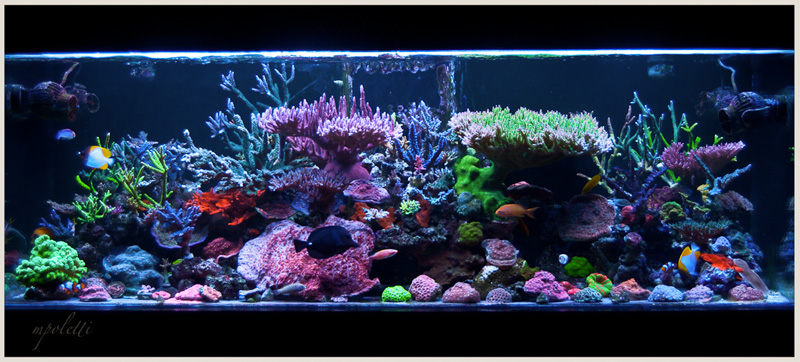 |
Introduction
Before I get started, I would like to thank my wife Amanda, my daughter Emma, Reef Central and the online community for allowing me to share what has been my dedication to the ups and downs of the hobby that we all share a passion for; again.
There are so many beautiful tanks around the world and each system is its own TOTM on different merits. Those unique qualities have inspired me time and time again over the years. The constant struggle of the ups and downs, the self-inflicted disasters, and the hours of mental preparation that go along with this hobby is what makes the small triumphs worth it.
The marine hobby has always fascinated me, from my early years of visiting the fish stores with my grandmother, to my latest tank. My name is Mark Poletti and I live in Sacramento, California. The reefkeeping community in Northern California has evolved over the years, but it still home to some of the most talented reefkeepers I know. I have met many great people because of this hobby and some may not have a tank today, but they are still part of my life. I’ve always been grateful to live where I do as our access to beautiful livestock continues to amaze me. Without close friends who share our similar passion, this hobby would not be what it is.
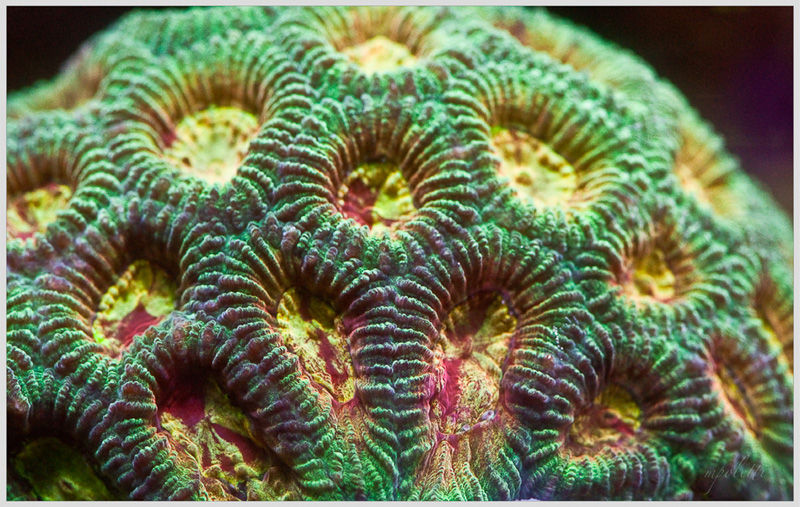 |
Background
My passion for what lives under the water’s surface has always been there, but my incurable disease manifested to where I am now when my wife and I honeymooned in Bora Bora. With my first dive under the water, I knew I was going to be setting up another tank. Through a series of different tanks, all having some failures and successes, I started making plans for my current tank, applying the knowledge and experience from my previous projects.
That was then. This is now.
As I mentioned above, there are many amazing systems in this hobby. With all of the technological advances, the only limit to a system nowadays is how much money a person wants to put into the tank and how much creativity and effort they are willing to explore. Many people discuss how the most enjoyable times in the hobby are revolved around setting up a new system. I completely agree. Unfortunately, my tank is five years old.
This dilemma has played mental tug a war with me since my tank crash about 3.5 years ago. Shortly after the prior TOTM, my tank went through a series of unfortunate circumstances. From my own boredom, to a faulty kh kit, to an unnoticed empty co2 tank, to more human error, to even more human error, I made the decision to start my tank completely over. What I found out the hard way, is that when a mature system is used to a particular style or manner of consistency, it might be better to keep trudging that path rather than changing too many things in a short period of time.
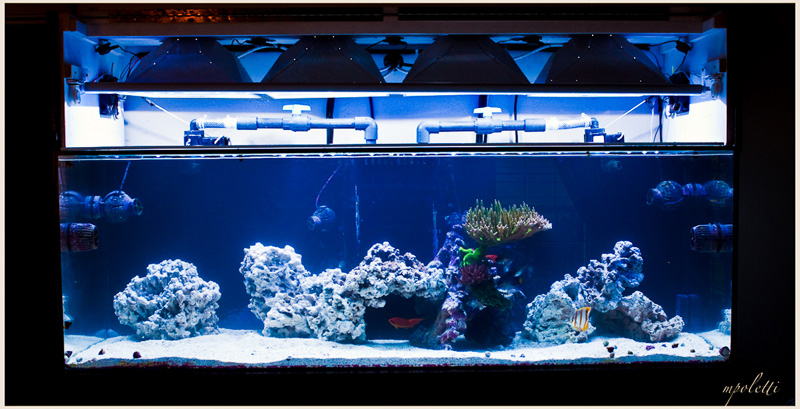 |
I was very proud of my last tank, maybe even too proud. I’ve always been motivated reading the old schoolers TOTM articles because they inspired me. I would read those articles and think if they could do it, so could I. My life revolved around my tank, the corals, the fish and the hobby in general. Water changes were scheduled into the family schedule, as well as vacations around reef conferences and fish stores. The TOTM curse taught me a lesson I needed to learn. That is why I agreed to this TOTM “refresh.” I say “refresh” because I will never see the tank for what it is now, just what it was then.
System Profile
• Display Aquarium: 180-gallon Lee Mar Starfire (72” x 24” x 24”)
• Sump: 42" x 20" x 16" custom sump
• Lighting display: 4 - 250-watt 20K Radiums, 2 - 250-watt SLS Blue Wave 7 HQI ballasts, 4 - Lumenarc mini reflectors, 2 - 160-watt URI Super Actinic VHOs, 1 - Coralvue 430 electronic ballast, 1 – 72” Sunbrite LED tube light, LED moonlights
• Chiller: Tradewinds USA 1/2hp
• Water Circulation: 2 - 6105 Tunzestream pumps, 2 – 6155 Tunzestream pumps & 2 - 6055 Tunze Nanostreams on a 7095 Tunze controller.
• Return: ATB flowstar 1500
• Calcium Reactor: AquaC RX-1 with course media with an Aquarium Plants electronic regulator
• Other: carbon and PO4 reactors, Spectrapure auto top-off, 7 stage RO/DI unit, Neptune Systems APEX controller, 10lb CO2 tank, Aquarium plants electronic regulator, 2 x 250-watt heaters, canopy fans, etc.
Tank
I am one of those people more concerned with color than growth. My experience showed me that corals will grow with patience, but selecting a few choice corals and placing them in optimal places really can make a difference. My problem is that I always pick too many corals.
The tank is viewable through Starphire glass on three sides, and I selected a center overflow due to my space limitations. The stand and canopy are handmade of red oak. Building, staining and finishing the tank was all part of that rush we get when setting up a new system. I followed an aggressive timetable and in a matter of a few weeks, I picked up the tank, built the stand canopy, plumbed in the tank and started adding livestock.
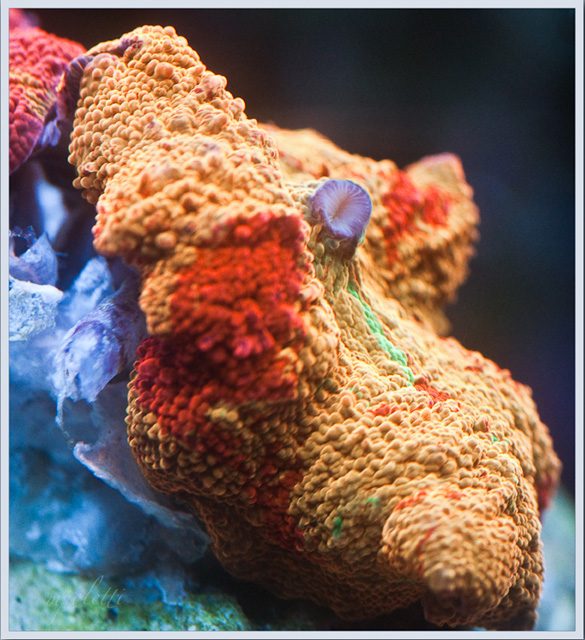 |
Filtration
Clean, stable water is always my goal. I still use the ATB deluxe that I picked up over 4 years ago. Like it been said before, if it’s not broke, then there is no reason to fix it. My sump houses two media reactors for carbon and ferric oxide. The tank also contains about 150 pound of liverock and one change I’ve made over time is that once a month, I try and siphon out the sand. I’ve been going barebottom for about 11 months. I still like the look of sand but as the corals grew larger, getting flow to all parts of the tank became an issue. The sand demonstrated it needed to go as I got tired of unburying corals on the sandbed.
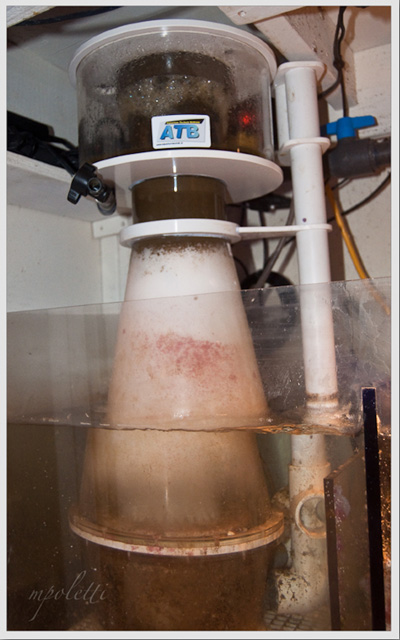 |
Water Circulation & Flow
I subscribe to the belief that flow in our tanks is very important. I’ve changed some things up over the years. I still have a pair of Tunze 6105 Stream pumps located in each back corner of the tank, but I also added a pair of 6155 Tunze Stream pumps. The 6105s and 6155’ are controlled by the 7095 multi-controller that also controls the pair of 6055 Tunze Nanostreams that are located behind the rock structure. This helped with my flow concerns, but even with these, my tank still has spots where I wish there was more flow.
The ATB flowstar 1500 return pump feeds the calcium reactor, media reactors and chiller and then feeds back into the tank.
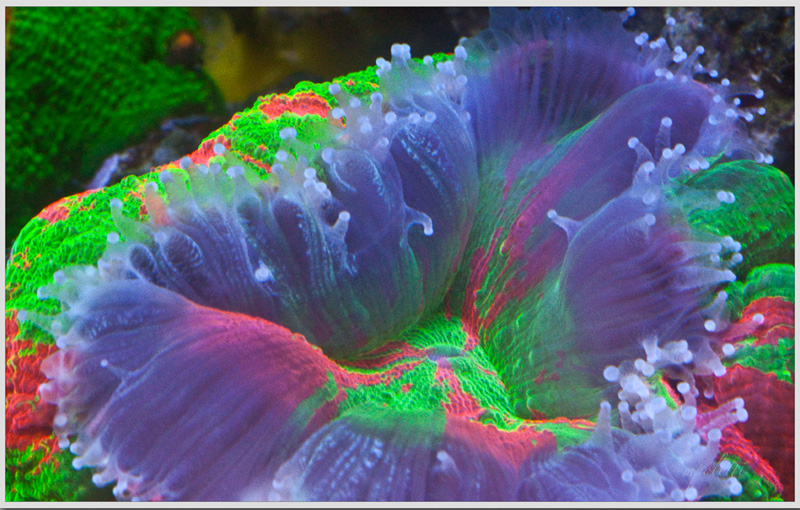 |
Lighting
A tank's lighting is a very personal choice and for some it’s a very difficult decision. There are so many different options available that have proven to work – especially with the expanding LED market. I prefer metal halides and VHO’s; it may be a little old school for some, but many of the tanks that have inspired me used metal halides and VHOs. When people come see the tank and view it with the only the VHOs on, I am reminded that I made the right choice.
I have tried many different options of lighting and when it came to this system, I went with four 250-watt Radiums. Some may say that 1000 watts of Radium bulbs are not needed, but I’m always interested in trying out something new. I also added a 72” LED Sunbrite tube for that late night enchinophyllia look.
|
Water Parameter Targets:
|
Maintenance, Feeding, & Supplements
Everyone wants to have a beautiful and colorful reef tank, but many people are not willing to do the little things to present a quality finished product. This is something I don’t understand when it comes to our hobby. I enjoy the opportunity to care for living creatures, and I want to attempt to create the best environment for them. I believe in regular water changes. I strive for weekly 40-gallon water changes. My RO/DI station has seven stages to ensure the water is prepared properly. The new saltwater consists of a mix a few different salt mixes to balance the highs and lows from the various salts. During the weekly water changes, I add three cups of magnesium chloride (mag flake) to keep the tank's magnesium level where I like it.
That’s what I wrote 4 years ago…
Things have definitely changed. I still have some of the same lofty goals, but my motivation and desire to stay on top of things has dwindled over time. I haven’t tested for Calcium, PH, nitrates, or phosphates in over 3 years, maybe longer. I don’t even test for kh on a regular basis anymore, maybe twice a month. I still try and perform a 40-gallon water change once or twice a month, but even that schedule has no regularity.
I’ve tried all the cool marketed products on the market, from ZEOvit, to vodka, to vinegar, to bio-pellets, to amino acids, but when I do use any extra products with any consistency, I use Prodibio bacteria products. I use Bioptim and Biodigest in alternating weekly dosing, and I dose the Reefbooster product when I’m up early on Saturday mornings watching Liverpool FC games.
I heavily feed my tank as I like to watch the fish eat. It’s still one of my favorite parts of the hobby and one that I still enjoy on a daily basis. I feed my tank both frozen and prepared foods. My wife has just accepted over time that it’s part of the fridge and freezer. I feed frozen brine, enriched brine, and mysis, as well as arctic pods and ROE from Reef Nutrition and prepared coral food and pellets by Coral Frenzy.
 |
Livestock
On to my favorite part of our hobby – the livestock. I still haven’t been able to decide which I enjoy more, the fish or the corals. I got into this hobby because I enjoyed the diversity and coloration of the fish. I can sit thoughtlessly and watch the fish swim back and forth in the water column. I went through a rare fish phase, including a pair of joculators and quite a few high-end fairy wrasses, but due to nature, and some unfortunate circumstances, I lost quite a few of those fish.
As my daughter Emma continues to grow up, she’s become my fish store partner and I will be forever grateful for the time I’ve shared with her. The questions she’s asked and her researching fish in the Scott Michael books have weighed on my mind multiple times when I’ve debated pulling the plug once and for all.
I have had up to 40 fish in this tank at one time, but currently, I have around 30. My livestock has turned over as time has passed, but the black tang is the godfather of my tank. He decides if a new fish addition is welcome or not. My current stock list is:
Today, and still, my tank is stocked by my infatuation with various stony corals. The colors and growth of each coral is what has flourished my love for them. Presently, the tank houses over 100 different variations of coral and each one has its own memory attached. I am not going to mention every species of coral in my tank, but I am proud that 95% of the corals I house are all captive-raised second generation or later and have been grown out from coral fragments.
Over time, and as the corals have grown out to fight over light and flow, I’ve had to remove some corals and move them into the garage system. The growing out of the coral colonies has presented its own set of issues. Not only have the corals naturally selected which corals would take each other, the larger colonies also create the task of getting ample flow and light to all areas of the tank quite difficult at times. The garage system not only allows me a place for corals that grow out, but it also allows me to quarantine every single coral I get for a minimum of three weeks. I recommend every person who keeps corals to also have a separate system, if possible, for new coral treatment and observation. Believe me, hobby pests are not fun and tossing a newly purchased coral is not worth the headache and stress that could happen down the road.
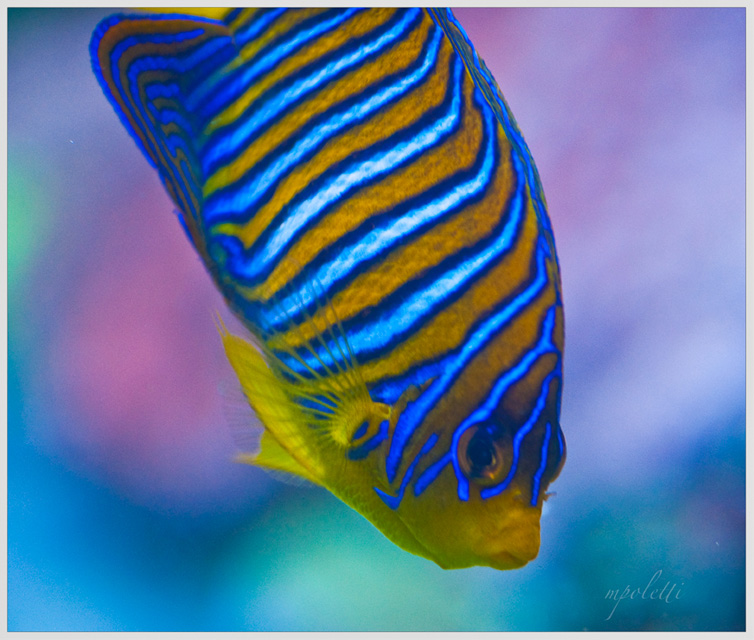 |
Conclusion
Our hobby is an amazing hobby. It’s enabled me to share my personality and lifestyle with so many, and stroked my ego from time to time as well. In turn, my family's life has been touched in ways that cannot be described.
If I could offer any advice, it would be to enjoy whatever you’re doing in the hobby. Concentrate on your own tank and not someone else’s online tank thread. I’ve felt that the hobby has been a chore at times and because of that, I gave up chasing numbers a few years ago. I no longer needed to have the “perfect” tank – just the one I can accept the results for the effort I put in.
I have battled the triad of pests, and I have come out on the other side. I have experienced tank crashes and user errors, and I have come out on the other side. I have had my ups and downs just like the next person, but through it all, the tank has always made me smile.
There are many other people that have showed me the correct way to be a responsible reefkeeper: from the local clubs, fellow reefkeepers, the online cyber community, and a few local fish stores. I would like to thank them, the staff at Reef Central, and the team members of TeamRC for acknowledging my tank as worthy of this feature.
 |
Feel free to comment or ask questions about my tank in the Tank of the Month thread on Reef Central.



